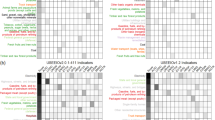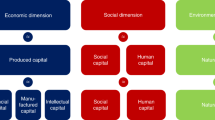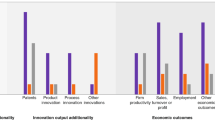Abstract
Technology-rich integrated assessment models (IAMs) address possible technology mixes and future costs of climate change mitigation by generating scenarios for the future industrial system. Industrial ecology (IE) focuses on the empirical analysis of this system. We conduct an in-depth review of five major IAMs from an IE perspective and reveal differences between the two fields regarding the modelling of linkages in the industrial system, focussing on AIM/CGE, GCAM, IMAGE, MESSAGE, and REMIND. IAMs ignore material cycles and recycling, incoherently describe the life-cycle impacts of technology, and miss linkages regarding buildings and infrastructure. Adding IE system linkages to IAMs adds new constraints and allows for studying new mitigation options, both of which may lead to more robust and policy-relevant mitigation scenarios.
This is a preview of subscription content, access via your institution
Access options
Access Nature and 54 other Nature Portfolio journals
Get Nature+, our best-value online-access subscription
$29.99 / 30 days
cancel any time
Subscribe to this journal
Receive 12 print issues and online access
$209.00 per year
only $17.42 per issue
Buy this article
- Purchase on Springer Link
- Instant access to full article PDF
Prices may be subject to local taxes which are calculated during checkout



Similar content being viewed by others
References
IPCC Climate Change 2014: Mitigation of Climate Change (eds Edenhofer, O. et al.) (Cambridge Univ. Press, 2015).
Moss, R. H. et al. The next generation of scenarios for climate change research and assessment. Nature 463, 747–756 (2010).
McJeon, H. C. et al. Limited impact on decadal-scale climate change from increased use of natural gas. Nature 514, 482–485 (2014).
Glynn, J. et al. Informing energy and climate policies using energy systems models. 30, 359–387 (2015).
Grubler, A. et al. The Global Energy Assessment: Toward a More Sustainable Future (GEA, IIASA, 2012).
Hejazi, M. et al. Long-term global water projections using six socioeconomic scenarios in an integrated assessment modeling framework. Technol. Forecast. Soc. Change 81, 205–226 (2014).
Energy Technology Perspectives 2015 (IEA, 2015).
Smith, S. J. et al. Long history of IAM comparisons. Nat. Clim. Change 5, 391 (2015).
Kriegler, E. et al. Making or breaking climate targets: the AMPERE study on staged accession scenarios for climate policy. Technol. Forecast. Soc. Change 90, 24–44 (2015).
Fischer-Kowalski, M. & Weisz, H. Society as hybrid between material and symbolic realms: toward a theoretical framework of society-nature interaction. Adv. Hum. Ecol. 8, 215–251 (1999).
Hellweg, S. & Milà i Canals, L. Emerging approaches, challenges and opportunities in life cycle assessment. Science 344, 1109–1113 (2014).
Wiedmann, T. O. et al. The material footprint of nations. Proc. Natl Acad. Sci. USA 112, 6271–6276 (2015).
Pauliuk, S. & Müller, D. B. The role of in-use stocks in the social metabolism and in climate change mitigation. Glob. Environ. Change 24, 132–142 (2014).
Müller, D. B., Wang, T., Duval, B. & Graedel, T. E. Exploring the engine of anthropogenic iron cycles. Proc. Natl Acad. Sci. USA 103, 16111–16116 (2006).
Graedel, T. E., Harper, E. M., Nassar, N. T. & Reck, B. K. On the materials basis of modern society. Proc. Natl Acad. Sci. USA 112, 6295–6300 (2013).
Lenzen, M. & Reynolds, C. J. A supply-use approach to waste input-output analysis. J. Ind. Ecol. 18, 212–226 (2014).
Chertow, M. R. 'Uncovering' industrial symbiosis. J. Ind. Ecol. 11, 11–30 (2007).
Kennedy, C. A. et al. Energy and material flows of megacities. Proc. Natl Acad. Sci. USA 112, 5985–5990 (2015).
Ramaswami, A., Chavez, A. & Chertow, M. Carbon footprinting of cities and implications for analysis of urban material and energy flows. J. Ind. Ecol. 16, 783–785 (2012).
Creutzig, F. et al. Reconciling top-down and bottom-up modelling on future bioenergy deployment. Nat. Clim. Change 2, 320–327 (2012).
Dandres, T., Gaudreault, C., Tirado-Seco, P. & Samson, R. Assessing non-marginal variations with consequential LCA: application to European energy sector. Renew. Sustain. Energy Rev. 15, 3121–3132 (2011).
Earles, J. M. & Halog, A. Consequential life cycle assessment: a review. Int. J. Life Cycle Assess. 16, 445–453 (2011).
Daly, H. E., Scott, K., Strachan, N. & Barrett, J. R. The indirect CO2 emission implications of energy system pathways: Linking IO and TIMES models for the UK. Environ. Sci. Technol. 49, 10701–10709 (2015).
Pauliuk, S. & Hertwich, E. G. in Taking Stock of Industrial Ecology (eds Clift, R. & Duckmann, A.) 21–43 (Springer, 2016).
Hackett, S. B. & Moxnes, E. Natural capital in integrated assessment models of climate change. Ecol. Econ. 116, 354–361 (2015).
Harfoot, M. et al. Integrated assessment models for ecologists: the present and the future. Glob. Ecol. Biogeogr. 23, 124–143 (2014).
Strachan, N., Fais, B. & Daly, H. E. Reinventing the energy modelling–policy interface. Nat. Energy 1, 16012 (2016).
Peters, G. P. The 'best available science' to inform 1.5 °C policy choices. Nat. Clim. Change 6, 646–649 (2016).
Stern, N. Current climate models are grossly misleading. Nature 530, 407–409 (2016).
Hertwich, E. G. & Peters, G. P. Carbon footprint of nations: a global, trade-linked analysis. Environ. Sci. Technol. 43, 6414–6420 (2009).
Wiedmann, T. O. et al. A carbon footprint time series of the UK – results from a multi-region input–output model. Econ. Syst. Res. 22, 19–42 (2010).
Weinzettel, J., Hertwich, E. G., Peters, G. P., Steen-Olsen, K. & Galli, A. Affluence drives the global displacement of land use. Glob. Environ. Change 23, 433–438 (2013).
Lenzen, M. et al. International trade drives biodiversity threats in developing nations. Nature 486, 109–112 (2012).
Hertwich, E. G. et al. Integrated life-cycle assessment of electricity-supply scenarios confirms global environmental benefit of low-carbon technologies. Proc. Natl Acad. Sci. USA 112, 6277–6282 (2015).
Hawkins, T. R., Singh, B., Majeau-Bettez, G. & Strømman, A. H. Comparative environmental life cycle assessment of conventional and electric vehicles. J. Ind. Ecol. 17, 53–64 (2013).
Frischknecht, R. et al. The environmental relevance of capital goods in life cycle assessments of products and services. Int. J. Life Cycle Assess. 12, 7–17 (2007).
Yeh, S. & Sperling, D. Low carbon fuel standards: Implementation scenarios and challenges. Energy Policy 38, 6955–6965 (2010).
Creutzig, F., McGlynn, E., Minx, J. & Edenhofer, O. Climate policies for road transport revisited (I): evaluation of the current framework. Energy Policy 39, 2396–2406 (2011).
Grübler, A. The Rise and Fall of Infrastructures. (Physica-Verlag Heidelberg, 1990).
Müller, D. B. Stock dynamics for forecasting material flows - case study for housing in the Netherlands. Ecol. Econ. 59, 142–156 (2006).
Elshkaki, A., Graedel, T. E., Ciacci, L. & Reck, B. K. Copper demand, supply, and associated energy use to 2050. Glob. Environ. Change 39, 305–315 (2016).
Tanikawa, H. & Hashimoto, S. Urban stock over time: spatial material stock analysis using 4d-GIS. Build. Res. Inf. 37, 483–502 (2009).
Fischedick, M. et al. in Climate Change 2014: Mitigation of Climate Change (eds Edenhofer, O. et al.) Ch. 10 (IPCC, Cambridge Univ. Press, 2015).
Liu, G., Bangs, C. E. & Müller, D. B. Stock dynamics and emission pathways of the global aluminium cycle. Nat. Clim. Change 2, 338–342 (2012).
Milford, R. L., Pauliuk, S., Allwood, J. M. & Müller, D. B. The roles of energy and material efficiency in meeting steel industry CO2 targets. Environ. Sci. Technol. 47, 3455–3462 (2013).
Allwood, J. M., Cullen, J. M. & Milford, R. L. Options for achieving a 50% cut in industrial carbon emissions by 2050. Environ. Sci. Technol. 44, 1888–1894 (2010).
Ayres, R. U. & Kneese, A. Production, consumption, and externalities. Amer. Econ. Rev. 59, 282–297 (1969).
Frischknecht, R. et al. The ecoinvent database: overview and methodological framework. Int. J. Life Cycle Assess. 10, 3–9 (2005).
Finnveden, G. et al. Recent developments in life cycle assessment. J. Environ. Manage. 91, 1–21 (2009).
Graedel, T. E. et al. Multilevel cycle of anthropogenic copper. Environ. Sci. Technol. 38, 1242–1252 (2004).
Nakamura, S. & Kondo, Y. Input-output analysis of waste management. J. Ind. Ecol. 6, 39–63 (2002).
Majeau-Bettez, G., Wood, R. & Strømman, A. H. Unified theory of allocations and constructs in life cycle assessment and input-output analysis. J. Ind. Ecol. 18, 747–770 (2014).
Yu, C., Davis, C. & Dijkema, G. P. J. Understanding the evolution of industrial symbiosis research. J. Ind. Ecol. 18, 280–293 (2014).
Kennedy, C. A., Cuddihy, J. & Engel-Yan, J. The changing metabolism of cities. J. Ind. Ecol. 11, 43–59 (2007).
Kenworthy, J. R. & Laube, F. B. Patterns of automobile dependency in cities: an international overview of key physical and economic dimensions with some applications for urban policy. Transp. Res. Part A 33, 691–723 (1999).
Seto, K. C. et al. in Climate Change 2014: Mitigation of Climate Change (eds Edenhofer, O. et al.) Ch. 12 (IPCC, Cambridge Univ. Press, 2015).
Keirstead, J., Jennings, M. & Sivakumar, A. A review of urban energy system models: approaches, challenges and opportunities. Renew. Sustain. Energy Rev. 16, 3847–3866 (2012).
Rosen, R. A. IAMs and peer review. Nat. Clim. Change 5, 390 (2015).
Rosen, R. A. Critical review of: “Making or breaking climate targets — the AMPERE study on staged accession scenarios for climate policy”. Technol. Forecast. Soc. Change 96, 322–326 (2015).
Nakata, T. Energy-economic models and the environment. Prog. Energy Combust. Sci. 30, 417–475 (2004).
Fleiter, T., Worrell, E. & Eichhammer, W. Barriers to energy efficiency in industrial bottom-up energy demand models — a review. Renew. Sustain. Energy Rev. 15, 3099–3111 (2011).
Mundaca, L., Neij, L., Worrell, E. & McNeil, M. Evaluating energy efficiency policies with energy-economy models. Annu. Rev. Environ. Resour. 35, 305–344 (2010).
Worrell, E., Ramesohl, S. & Boyd, G. Advances in energy forecasting models based on engineering economics. Annu. Rev. Environ. Resour. 29, 345–381 (2004).
Nakata, T., Silva, D. & Rodionov, M. Application of energy system models for designing a low-carbon society. Prog. Energy Combust. Sci. 37, 462–502 (2011).
Grubb, M., Köhler, J. & Anderson, D. Induced technical change in energy and environmental modelling: analytic approaches and policy implications. Annu. Rev. Energy Environ. 27, 271–308 (2002).
Weyant, J. P. & Olavson, T. Issues in modeling induced technological change in energy, environmental, and climate policy. Environ. Model. Assess. 4, 67–85 (1999).
Matsuoka, Y., Morita, T. & Kainuma, M. in Present and Future of Modeling Global Environmental Change: Toward Integrated Modeling (eds Matsuno, T. & Kida, H.) 339–361 (TERRAPUB, 2001).
Dai, H., Masui, T., Matsuoka, Y. & Fujimori, S. Assessment of China's climate commitment and non-fossil energy plan towards 2020 using hybrid AIM/CGE model. Energy Policy 39, 2875–2887 (2011).
Fawcett, A. A. et al. Can Paris pledges avert severe climate change? Science 350, 1168–1169 (2015).
Thomson, A. M. et al. RCP4.5: a pathway for stabilization of radiative forcing by 2100. Climatic Change 109, 77–94 (2011).
van Vuuren, D. P. et al. RCP2.6: exploring the possibility to keep global mean temperature increase below 2 °C. Climatic Change 109, 95–116 (2011).
Deetman, S., Hof, A. F. & van Vuuren, D. P. Deep CO2 emission reductions in a global bottom-up model approach. Clim. Policy 15, 253–271 (2015).
Riahi, K., Grubler, A. & Nakicenovic, N. Scenarios of long-term socio-economic and environmental development under climate stabilization. Technol. Forecast. Soc. Change 47, 887–935 (2007).
Riahi, K. et al. RCP 8.5—A scenario of comparatively high greenhouse gas emissions. Climatic Change 109, 33–57 (2011).
Luderer, G. et al. The economics of decarbonizing the energy system-results and insights from the RECIPE model intercomparison. Climatic Change 114, 9–37 (2012).
Bauer, N. et al. Global fossil energy markets and climate change mitigation – an analysis with REMIND. Climatic Change 136, 69–82 (2016).
Fais, B., Sabio, N. & Strachan, N. The critical role of the industrial sector in reaching long-term emission reduction, energy efficiency and renewable targets. Appl. Energy 162, 699–712 (2016).
Arvesen, A., Bright, R. M. & Hertwich, E. G. Considering only first-order effects? How simplifications lead to unrealistic technology optimism in climate change mitigation. Energy Policy 39, 7448–7454 (2011).
Arvesen, A., Nes, R., Huertas-Hernando, D. & Hertwich, E. G. Life cycle assessment of an offshore grid interconnecting wind farms and customers across the North Sea. Int. J. Life Cycle Assess. 19, 826–837 (2014).
Kleijn, R. & van der Voet, E. Resource constraints in a hydrogen economy based on renewable energy sources: an exploration. Renew. Sustain. Energy Rev. 14, 2784–2795 (2010).
Gielen, D. J., Gerlagh, T. & Bos, A. J. M. MATTER 1.0 - A MARKAL Energy and Materials System Model Characterisation (Netherlands Energy Research Foundation ECN, 1998).
Frei, C. W., Haldi, P. A. & Sarlos, G. Dynamic formulation of a top-down and bottom-up merging energy policy model. Energy Policy 31, 1017–1031 (2003).
Böhringer, C. & Rutherford, T. F. Combining bottom-up and top-down. Energy Econ. 30, 574–596 (2008).
Suh, S. et al. System boundary selection in life-cycle inventories using hybrid approaches. Environ. Sci. Technol. 38, 657–664 (2004).
Schwanitz, V. J. Evaluating integrated assessment models of global climate change. Environ. Model. Softw. 50, 120–131 (2013).
Müller, D. B., Wang, T. & Duval, B. Patterns of iron use in societal evolution. Environ. Sci. Technol. 45, 182–188 (2011).
Casman, E. A., Morgan, M. G. & Dowlatabadi, H. Mixed levels of uncertainty in complex policy models. Risk Anal. 19, 33–42 (1999).
Liu, J. et al. Systems integration for global sustainability. Science http://doi.org/627 (2015).
Bollinger, L. A., Nikolić, I., Davis, C. & Dijkema, G. P. J. Multimodel ecologies: cultivating model ecosystems in industrial ecology. J. Ind. Ecol. 19, 252–263 (2015).
De Koning, A., Huppes, G., Deetman, S. & Tukker, A. Scenarios for a 2 °C world: a trade-linked input–output model with high sector detail. Clim. Policy 16, 301–317 (2015).
Wiebe, K. S. The impact of renewable energy diffusion on European consumption-based emissions. Econ. Syst. Res. 28, 133–150 (2016).
von Stechow, C. et al. Integrating global climate change mitigation goals with other sustainability objectives: a synthesis. Annu. Rev. Env. Resour. 40, 363–394 (2015).
Schäfer, A. Structural change in energy use. Energy Policy 33, 429–437 (2005).
Acknowledgements
A.A. received support from the Research Council of Norway through the Centre for Sustainable Energy Studies (contract 209697). The research was conducted without involvement of the funding sources. The authors thank V. Krey (MESSAGE), G. Luderer (REMIND), and S. Fujimori (AIM/CGE) for providing additional information and for commenting on earlier versions of this work. The authors thank E. Ó Broin for helping to review the AIM-CGE model and for his contribution to framing our review approach. The authors remain solely responsible for the content of this Perspective and for possible mistakes in the model review.
Author information
Authors and Affiliations
Contributions
S.P. and E.H. designed the approach, A.A., K.S., and S.P. performed the review, and all authors contributed to writing the paper.
Corresponding author
Ethics declarations
Competing interests
The authors declare no competing financial interests.
Supplementary information
Supplementary information
Industrial ecology in integrated assessment models (PDF 2469 kb)
Supplementary information
Industrial ecology in integrated assessment models (XLSX 346 kb)
Rights and permissions
About this article
Cite this article
Pauliuk, S., Arvesen, A., Stadler, K. et al. Industrial ecology in integrated assessment models. Nature Clim Change 7, 13–20 (2017). https://doi.org/10.1038/nclimate3148
Received:
Accepted:
Published:
Issue Date:
DOI: https://doi.org/10.1038/nclimate3148
This article is cited by
-
Challenges resulting from urban density and climate change for the EU energy transition
Nature Energy (2023)
-
Limited quantity and quality of steel supply in a zero-emission future
Nature Sustainability (2023)
-
An instrumental value-based framework for assessing the damages of abiotic resources use in life cycle assessment
The International Journal of Life Cycle Assessment (2023)
-
Sustainable pathways for attaining net-zero emissions in European emerging countries — the nexus between renewable energy sources and ecological footprint
Environmental Science and Pollution Research (2023)
-
Conditions for the broad application of prospective life cycle inventory databases
The International Journal of Life Cycle Assessment (2023)



